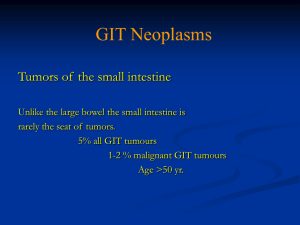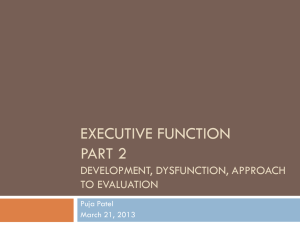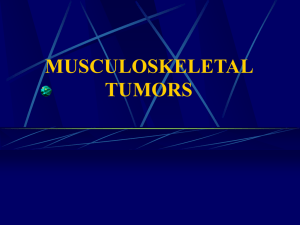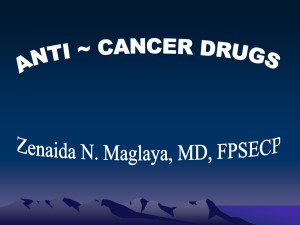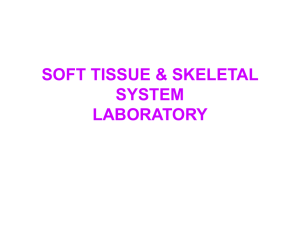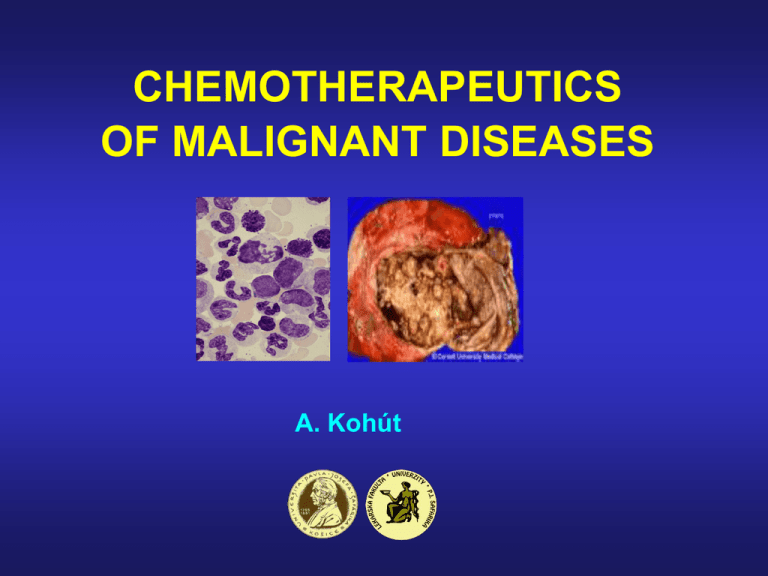
CHEMOTHERAPEUTICS
OF MALIGNANT DISEASES
A. Kohút
Carcinogenesis
DNA mutation
• hereditary
• acquired
radiation
viruses
chemicals
drugs
Categories of genetic changes
resulting in malignity
a) inactivation of tumor
supressor genes:
• mutation
• binding to a virus protein
• binding to a mutated
cellular protein
b) activation of
protooncogenes to
oncogenes:
• point mutation
(single nucleotide
polymorphisms-SNPs)
• gene amplification
• chromosome
translocation
• virus interaction
Oncogenes –
autonomy of cell growth
Oncogenes interfere with:
• mechanisms of proliferation
• mechanisms of differentiation
•
•
•
•
by means of:
production secretion of autocrine
growth factors
receptors for growth factors
cytosolic nuclear signal pathways
transduction systems controling cell cycle
Characteristics of tumour cells
• uncontrolled proliferation
• dedifferentiation loss of function
• invasiveness
• metastatic potential
Therapeutic effect of anticancer drugs
a. The therapeutic effect of anticancer drugs may require total
tumor cell kill, which is the of all neoplastic cells.
b. Achievement of a therapeutic effect often involvs drugs that have
a narrow therapeutic index (TI).
c. A therapeutic effect is usually achieved by killing activelly
growing cells, which are most sensitive to this class of agents.
d. Because normal cells and cancer cells have similar sensitivity to
chemotherapeutic agents, adverse effects are mostly seen in
normally dividing non-neoplastic cells, sach as:
hair follicles, bone marrow, sperm.
e. To minimize the adverse effects and resistance, often is used
combination of several agents with different mechanism of
action.
f. Achievement of a therapeutic effect may involve the use of drugs,
sometimes sequentially (at specific stages of cell cycle).
„PRODRUGS“
1. Cyclophosphamide 4-Hydroxyphosphamide (liver)
2. Procarbazíne dacarbazine (liver)
3. Merkaptopurine 6-merkaptopurine ribozophosphate
4. Tioquanín 6-tioquanín-ribózophosphate
5. Fluorouracil 5-fluoro-deoxy- uracil monophosphate
7. Mitomycin (only at the hypoxic tissue of tumors)
8. Doxorubicin idarubicin
SENSITIVITY OF TUMOURS TO
CHEMOTHERAPY
• chemosensitive tumours
• intermediary chemosensitive
tumours
• chemoresistant tumours
Chemosensitive tumours
• generally sensitive to several drugs
• combined chemotherapy is prefered
• chemotherapy is always indicated
Intermediary chemosensitive
tumours
• complete remission rate about 10%
• high partial response (about 50%)
• combined chemotherapy is slightly
more effective
• chemotherapy could be used
(no as first-choice therapy)
Chemoresistant tumours
• low response rate (about 20%)
• complete remission is rare
• chemotherapy has only adjuvant role
• neoadjuvant therapy
Factors influencing
chemotherapy response
• fraction of proliferating cells
• cell cycle rate
• synchronisation of cell cycle within tumour
• tumour mass
large tumours are relatively less sensitive:
1. a lot of cells in G0
2. penetration of drugs
• kinetics of cell killing
cytotoxic drugs kill only a part of cells of certain type
• resistance of tumour cells
Mechanisms of resistance I.
• Defect activation
– cyclophosphamide needs metabolic activation
– metothrexate needs conversion to MTXpolyglutamate in cells
• Increased inactivation
– sulfhydryl substances - glutathion, metalothionein – scavenge
reactive molecules
– aldehyde dehydrogenase – inactivation of cyclophosphamide
• Increased nucleotide levels
– can affect the effectiveness of antimetabolites
• Changes in DNA repare
– repare mechanisms, elimination of cross-links
– bleomycine other DNA-interfering drugs
Mechanisms of resistance II.
• Changes in target structure
– active enzyme with lower drug affinity:
DFR-metothrexate
• Reduced quantity of target structure
– amount of topo II: etoposide
• Gene amplification
– metothrexate: DFR requires more MTX
to block the activity
Mechanisms of resistance III.
• Decreased accumulation
– Decreased uptake
• MTX - protein transporter
• melphalan/leucine transport
– Increased efflux
• multidrug resistance (MDR):
- most often for natural drugs doxorubicine,
etoposide, actinomycine D, vinca alcaloids
- Pgp is normally expressed in some cells, e.g. stem
cells in bone marrow
Combination chemotherapy
•
tumours have tendency to be resistant to
some drug (cell heterogeneity)
•
resistance is often required during therapy
with only one drug (proliferation of mutated
cells)
•
several sites of effect are possible with
drugs with different side effects
•
cummulative biochemical damage
appear in cancer cells
MODALITIES OF ANTICANCER
CHEMOTHERAPY
1. Intermittent application
•
•
period for bone marrow regeneration
period for immunity regeneration
2. Continual therapy
•
during maintenance therapy
(chlorambucil in CLL, busulfan in CML, hormones or
antagonists in prostate or breast carcinoma)
3. Special applications
•
•
instilation in malignant secretions (bleomycine, thiotepa)
(can be palliative by volume reduction)
intrathecal (metothrexate)
(infiltration of CNS in leukemia)
INDIVIDUALISATION OF
CANCER THERAPY
Type of tumour:
•
selection of anticancer drug
•
combination (or not)
Repeated evaluation of clinical status:
•
continuation (or not) in agressive therapy
Continual monitoring of bone marrow:
•
before & during therapy
•
reduction (or not) of therapeutic regimen
intensity
The use of drugs modifying unwanted side effects:
•
antiemetics, colony-stimulating factors
•
increase in therapeutic:toxic ratio
PRACTICAL USE OF
ANTICANCER DRUGS
• the doses are expressed in
mg per m2
of body surface
(more precise dose/effect ratio)
Toxic effects
of anticancer chemotherapeutics
• myelotoxicity
• alopecia
• loss of appetite &
weight
• nausea & vomitus
• taste change
• stomatitis,
esophagitis,
constipation, diarrhea
• fatigue
•
•
•
•
•
•
•
•
cardiotoxicity
neurotoxicity
lung damage
sterility &
teratogenicity
hepatotoxicity &
nefrotoxicity
↓ wound healing
↓ growth (children)
carcinogenicity
ANTICANCER DRUGS
Mechanism of action - cell cycle
• intercalation
• blockade of metabolic
steps in DNA
synthesis
• of enzymes
regulating cell cycle
• RNA synthesis
• protein synthesis
• microtubular
functions
Cell cycle intervals &
anticancer drugs interferrence
Anticancer drugs
1.
2.
3.
4.
5.
6.
7.
alkylating agents (cyclophosphamide, cisplatin)
antimetabolites (methotrexate)
cytotoxic ATB (antracyclines)
mitosis inhibitors (vincristine, taxans)
topo inhibitors (topotecan, etoposide)
hormones (corticoids, tamoxifen, flutamide)
enzymes & other drugs (asparaginase,
procarbazine, hydroxyurea)
PTK inhibitors (imatinib)
8.
9. monoclonal antibodies
(rituximab,trastuzumab)
I. Alkylating agents
•
•
•
•
•
•
•
•
cyclophosphamide
platinum derivatives
derivatives of nitrosourea (lomustine,
carmustine)
estramustin
melphalan
chlorambucil
busulphan
dacarbazine
Mechanism of action
•
inter- or intra-chain cross-linking
•
interference with transcription &
replication (S phase & G2 block)
•
apoptosis
Alkylating agents
Side effects
• myelosuppresion
• GIT toxicity
• inhibition of gametogenesis
(sterility-males)
• secondary malignities
(acute leukemias)
Cyclophosphamide
(mustard gas)
• frequently used
• also as
immunosupressive
agent
• P-450 activation
• p.o., i.v, i.m.
• derivative - ifosfamide
Cyclophosphamide
Side effects
• myelosuppression
• GIT toxicity
• hemorrhagic cystitis –
acroleine
N-acetylcyst., mesna
Cisplatin, carboplatin
• platinum complex
2 chlorid ions
2 amonium groups
• cross-linking,
DNA denaturation
• solid tumors - testes
& ovarial
Cisplatin
Kinetics
slow i.v. perfusion
(water soluble)
Side effects
• myelosuppression
• GIT toxicity
• nephrotoxicity
• emetogenity
• ototoxicity
• neuropathies
II. Antimetabolites
•
Antagonists of folic acid
•
Pyrimidine derivatives
(thymine, cytosine, uracil)
DNA
•
RNA
Purine derivatives
(adenine, guanine)
Methothrexate
(antifolate)
Mechanism of action
• folates – purine nucleotides – thymidilate
– DNA
• reduction to FH4
• DHFR - high affinitt for FH4 - key enzyme
• transport of monocarbon groups
• uracile methylation to 2-deoxyuridylate
(DUMP) & thymidylate (DTMP)
• DNA synthesis
Methothrexate
Kinetics
• low liposolubility
• p.o., i.v., i.m., i.t.
• folate transport
(in the cell)
• polyglutamation
(intracellular)
• higher affinity
to DHFR as FH2
• FH4 depletion
Side effects
• myelosuppression,
GIT, pneumonitis,
nephrotoxicity (tubular
precipitation - hydratation)
• high doses – followed
by folic acid
Fluorouracil (5-FU)
(pyrimidine (uracile) derivative)
Mechanism of action
• interference with
thymidylate & DNA
synthesis
• fluorodeoxyuridine
monophosphate
formation (FDUMP)
• parenteral application
• mainly solid tumors
(GI)
Side effects
• GI epithelial damage
• myelotoxicity
Cytarabine
(pyrimidine (cytidine) derivative)
Mechanism of action
• intracellular
phosphorylation
• DNA & RNA
incorporation
• DNA polymerase
inhibition
• Inhibition of
replication &
reparation
Kinetics & indications
• s.c. (myelodysplastic
syndrome), i.v., i.t.
• AML, CML remission,
lymphoma,
myelodysplast. sy
Side effects
• myelosuppression, GIT,
nausea, vomiting
III. Cytotoxic ATB
• Anthracyclines
(daunorubicine, doxorubicine, epirubicine,
idarubicine)
• Bleomycines
Daunorubicine
(anthracycline)
Mechanism of action
• intercalating ATB
• topo II inhibition
Indications
• induction therapy
ALL, AML,
CML blast. trans.
Kinetics
• i.v. infusion
• metab. & excretion
(mainly liver)
Side effects
• myelotoxicity
• accumulative cardiotoxity (free radicals)
• alopecia
• local necrosis
(extravascular appl.)
Doxorubicine
(anthracycline)
Mechanism of action
• intercalating ATB
• inhibition of topo II
• much broader
indication spectrum as
dau
• Hodgkin, NHL,
myeloma, at least all
localizations of solid
tumors
• i.v. perfusion,
intravesically
Side effects
• myelotoxicity
• cardiotoxicity
(dexrazoxan)
• alopecia, mucositis,
necroses in mouth & if
applied paravenously
Bleomycines
(glycopeptide ATB-radiomimetic)
• Fe ion chelatation,
interaction with O2
• superoxide &
hydroxyl radicals
• degradation of
preformed DNA
• chain fragmentation
• radiomimetic effect
• most effective in G2 &
M phase, as well as G0
• testicular tumors &
malignant lymphomas
• orofacial tumors, ca
vulvae, penis, skin
• i.v., i.m.
•
•
•
•
Side effects
shivering, fever
lung fibrosis
allergies, mucocutaneous
reactions
low hemat. tox.
IV. Mitosis inhibitors
• Vinca alcaloids
(vincristine, vinblastine, vinorelbine)
• Taxans
(paclitaxel, docetaxel)
Mechanism of action
Inhibition of polymerisation:
colchicin
vinca alcaloids
Tubuline
Microtubulus
Stimulation of polymerisation
taxans
Inhibition of depolymerisation
Vincristine (vinblastine, vinorelbine)
(mitosis inhibitors)
Mechanism of action
• inhibition of tubuline polymerisation
• inhibition of mitotic spindle
formation
• effective in G2/M phase
•
•
•
•
Side effects
myelosuppression
phagocytosis, chemotaxy of
leukocytes
axonal transport in neurons
paresthesies, neuromuscular
abnormalities
Vincristine, vinblastine
Indications
Vincristine
• ALL & AML
• Hodgkin lymphoma, NHL
• multiple myeloma
• combination therapy in some solid tumors
Vinblastine
•
•
•
•
Hodgkin lymphoma, NHL
testicular tumors
choriocarcinoma
Grawitz tumor
Paclitaxel, docetaxel
(mitosis inhibitors)
Mechanism of action
• microtubular
stabilisation
• final effect like
vinca alcaloids
Kinetics
• very low water
solubility
• only as i.v. perfusion
Paclitaxel, docetaxel
Side effects
• myelosuppression
• neurotoxicity
• hypersensitivity
(premedication with
steroids & antihistaminics)
Indications
• metastatic tumors
(breast)
• progressive ovarial
tumors
• NSCLC
• Kaposi sarcoma (AIDS)
V. Topoisomerase inhibitors
• topo I inhibitors
(topotecan, irinotecan)
• topo II inhibitors
(etopozide, tenipozide)
Topotecan (irinotecan)
(topo I inhibitors)
Mechanism of action
• topo I inhibition
• its levels are during
the whole cell cycle
Side effects
• diarrhea, reversible
myelosuppression
• relatively low toxicity
Indications
• metastatic ovarial
tumors in case of first
line therapy failure
(topotecan)
• colorectal ca in
progress (irinotecan)
Etopozide (tenipozide)
(topo II inhibitors)
Mechanism of action
• Inhibition of
mitochondrial
functions &
nucleoside transport
• topo II inhibition
Side effects
• nausea, vomitus
• myelosuppression,
alopecia
Indications
• solid tumors
(lung-SCLC, testicular,
trophoblast, ovarial,
urinary blader)
• malignant lymphoma,
acute non-lymphatic
leukemia
VI. Hormones
• Glucocorticoids
(prednisolone, dexamethasone)
• Antihormones
(tamoxifen, flutamid)
Tamoxifen (toremifen)
Mechanism of action
• nonsteroidal
antiestrogene
• inhibits estradiol
binding to receptors
Indications
• p.o. appl. in breast
cancer with positive
estrogene receptors
Side effects
•
•
•
•
•
metrorhagies
thrombophlebitis
flush
alopecia
estrogene
endometrial effect
VII. Enzymes
& other chemotherapeutics
• Enzyme
(asparaginase)
• Other chemotherapeutics
(procarbazine, hydroxyurea)
Asparaginase
(enzyme)
•
•
•
•
Mechanism of action, kinetics, indications
cleaves asparagine, useful in malignities
where the cells lost possibility of its
synthesis
i.m., i.v. in ALL
Side effects
weak myelosuppression, GIT toxicity &
alopecia
nausea, vomiting, CNS depression,
anaphylaxis, hepatotoxicity
VIII. PTK inhibitors
(imatinib mesylate)
Mechanism of action, kinetics, indications
• PTK inhibition
• phosphate group transport from ATP
& phosphorylation of tyrozine residues in substrate
proteins
• Inhibition of transduction signals transmission
• p.o. appl. in therapy of CML & GIST
Side effects
• nausea, vomiting, diarrhea
• edema, headache & muscle pain
• neutropenia & thrombocytopenia
IX. Monoclonal antibodies
(rituximab, trastuzumab)
Rituximab
• monoclonal antibody only for i.v. appl.
• indicated in lymphoma therapy
Trastuzumab
• monoclonal antibody only for i.v. appl.
• indicated in HER2 Neu positive breast ca therapy
Side effects
•
•
•
•
pseudoinfluenza sy.
fever
headache, chest, abdominal, muscle & joint pain
nausea, vomiting, diarrhea & exanthema
Angiogenesis in cancer
Vasculogenesis vs Angiogenesis
Vasculogenesis
Formation of blood vessels
from differentiating
angioblasts and their
organization into a
primordial vascular
network, consisting of the
major blood vessels of the
embryo
Agiogenesis
Formation of vascular
sprouts from preexisting vessels
Physiological versus pathological
angiogenesis
Physiological
angiogenesis
Pathological angiogenesis
Therapeutic goal
Embryogenesis
Female reproductive
system
Development of
follicles
Corpus luteum
formation
Embryo implantation
Successful wound
healing
Inhibition of angiogenesis
Stimulation of
angiogenesis
Hemangiomas
Psoriasis
Kaposi's sarcoma
Ocular neovascularization
Rheumatoid arthritis
Endometriosis
Atherosclerosis
Myocardial ischemia
Peripheral ischemia
Cerebral ischemia
Wound healing
Reconstructive surgery
Ulcer healing
Tumor growth
and metastasis
Progression of Cancer
Established tumor
1 kg
1g
Dormant in situ Cancer
1 mg
Initiation
Promotion
Hypoxia crosstalk
Dormant cancer cells
regain tumorigenic
potential
1 mg
Suzuki M et al AJP 169: 673-681
Accessory
cells
Angiogenic switch
1 ng
The balance hypothesis for the
angiogenic switch
VEGF family
FGF family
PDGF
TGF family
Angiogenin
Angiopoietin-1/Tie2
TNF-a
HGF/scatter factor
IGF family
IL-8
Nitric oxide
Prostaglandins
Tissue factor
MMPs
.
.
.
Hanahan D & Folkman J. Cell. 86:353, 1996
Angiostatin/other
plasminogen kringles
Antithrombin (cleaved)
Endostatin
Fibronectin fragments
PEX
16-kDa Prolactin
Prothrombin kringle-2
Maspin
Restin
Vasostatin
IL-1, -4, -10, -12, -18
IFNs
TIMPs
1,25-(OH)2-vitamin D
2-Methoxyestradiol
Angiopoietin-2
EMAP-II
gro-b
IP-10
.
.
.
Normal Blood Vessels vs Tumor Blood Vessels
McDonald & Choyke Nat Med 2003
Bevacizumab
• Recombinant, humanized monoclonal
antibody that binds to VEGF-A
• Approved for first-line treatment of Non-Small
Cell Lung Cancer in combination with
Carboplatin and Paclitaxel
• Adding bevacizumab to chemotherapy results
in increased median Progression Free
Survival by 33%
Concerns
• Since bevacizumab is expected to inhibit new
angiogenic growth, concerns have been
raised regarding postoperative wound-healing
and bleeding complications in patients who
undergo surgery within 1 to 2 months of
Bevacizumab therapy
Side efects
• Gastrointestinal (GI) perforation
• Wound healing complication
• Hemorrhage
• Neutropenia
Immunosuppressant drugs
- inhibit interleukin-2 production or action
cyclosporin, tacrolimus, sirolimus
- inhibit cytokine gene expression
corticosteroids
- inhibit purine and pyrimidine synthesis
azathioprine
- block the T cell surface molecules involved in
signalling
polyclonal and monoclonal antibodies
- act by cytotoxic mechanisms
cyclophosphamide, chlorambucil
Usage in therapy:
- autoimmune disease (some forms of
haemolytic anaemia, glomerulonephritis…)
- prevention /or therapy of
transplant rejection (kidneys, bone
marrow, heart, liver, etc.)
Hazard:
- decreased response to infections
- facilitation of emergence of
malignant cells
Cyclosporin
-a fungal polypeptide with potent
immunosuppresive activity
Pharmacokinetics
- i.v., oral absorption
- hepatic metabolism-metabolites excreted in
the bile
-accumulation in most tissues at conc. 3 to 4
times that seen in the plasma
Unwanted reactions:
- nephrotoxicity
- hepatotoxicity
- hypertension
Tacrolimus
- a macrolide antibiotic
- i.v., orally
- metabolized by the liver
Unwanted reactions:
- neurotoxicity
- GIT upsets, metabolic disturbances
(hyperglycaemia) reversible by reducing the
dosage
Glucocorticoids
- restrain the clonal proliferation of Th cells through
decreasing transcription of the gene for IL-2
- decrease the transcription of many other
cytokine genes in both the induction and effector
phases of the immune response
Azathioprine
is activated to 6-mercaptopurine (a pure analogue –
antimetabolite - that inhibits DNA synthesis)
by a cytotoxic action on dividing cells inhibits clonal
proliferation in the induction phase of the immune
response
Unwanted reactions:
- depression of the bone marrow,
- nausea and vomiting
Mycophenolate mofetil
A semisynthetic derivative of a fungal antibiotic
bioactivated to mycophenolic acid
Action (fairly selective):
- restrains proliferation of both T and B lymphocytes
- reduces the production of cytotoxic T cells
Kinetics:
Well absorbed from the GIT
Enterohepatic circulation-inactive glucuronides


